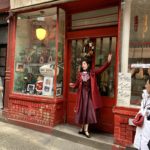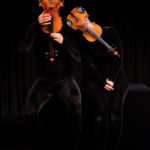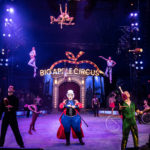I wasn’t born in NYC but I became an official New Yorker on 9/11. I was in the city when the towers fell and from that day on, I was no longer an ex-pat. My accent got thicker, my roots got tighter and I set down my fort and never left. Just a few years later, I would bring two children into this world and they would inherit my fierce patriotism to the city we live in. Our passion for the city is universal and I never have to struggle to get my kids in for a dose of culture.
So, during the February break, I decided it was time to visit the Museum of the City of New York to learn about our city’s history and celebrate its incredible evolution over the years. I wanted them to understand all the changes NYC has endured since its inception in the 1600s and how grateful we really should be to live here.
Mission accomplished. After several hours of exploring the museum’s exhibits about the past, present and future of the city, I think my children have a better understanding of all the work and love that goes into making NYC one of the greatest cities in the world. At ages eight and nine, they are able to make more sense of the information they are taking in. They waded through the paintings, sculptures, photographs, theater souvenirs, manuscripts, rare books and clothes from the 1800s and watched the transformation of the city go from farmland to a vast, urban landscape. My daughter and I gawked at the Stettheimer Dollhouse on the ground floor, created by Carrie Stettheimer in the 1920s, whose artists friends created masterpieces to don the house’s walls. I used to love doll houses when I was a kid, so it brought back memories.
Here is some information about the exhibits we explored today:
Making Room: New Models for Housing New Yorkers, Jan 23rd through Sep 15th
Making Room: New Models for Housing New Yorkers showcases innovative design solutions to better accommodate New York City’s changing, and sometimes surprising, demographics, including a rising number of single people, and will feature a full-sized, flexibly furnished micro-studio apartment of just 325 square feet – a size prohibited in most areas of the city. Visitors to the exhibition will see models and drawings of housing designs by architectural teams commissioned in 2011 by Citizens Housing & Planning Council, in partnership with the Architectural League of New York. The exhibition also presents winning designs from the Bloomberg administration’s recently launched pilot competition to test new housing models, as well as examples set by other cities in the United States and around the world, including Seattle, Providence, Montreal, San Diego, and Tokyo.
Activist New York, Ongoing
Activist New York explores the drama of social activism in New York City from the 17th century right up to the present. In a town renowned for its in-your-face persona, citizens of the city have banded together on issues as diverse as historic preservation, civil rights, wages, sexual orientation, and religious freedom. Using artifacts, photographs, audio and visual presentations, as well as interactive components that seek to tell the entire story of activism in the five boroughs,
Timescapes: A Multimedia Portrait of New York, Ongoing
Timescapes, an engrossing 22-minute multimedia experience, traces the growth of New York City from a settlement of a few hundred Europeans, Africans, and Native Americans to its present status as one of the world’s great cities. Created by Jake Barton of Local Projects and James Sanders, co-writer of the PBS series New York: A Documentary History, and narrated by actor Stanley Tucci, the film features animated maps and archival photographs, prints, and paintings from the Museum’s collections.
Designing Tomorrow: America’s World’s Fairs of the 1930s, Dec 5 through Mar 31
Designing Tomorrow: America’s World’s Fairs of the 1930s showcases six Depression-era expositions that brought visions of a brighter future to tens of millions of Americans. As many Americans still waited on bread lines, fairs in Chicago (1933/34), San Diego (1935/36), Dallas (1936), Cleveland (1936/37), San Francisco (1939/40), and New York (1939/40) foretold much of what would become commonplace in postwar America–from highways and the spread of suburbia to modernist skyscrapers and products such as electric toasters, nylon stockings, and television. The fairs looked forward to an era of prosperity, when ingenuity and innovation would transform not only American cities but also the everyday lives of American citizens. Visitors will see sleek, modern furniture and appliances of the era, vintage footage from the fairs, and futuristic drawings of the New York World’s Fair’s buildings from the Museum’s collection.
Currier & Ives and Other Winter Tales, Opens Dec 15th, 2012
Currier & Ives and Other Winter Tales presents highlights from the Museum’s exceptional collection of works by 19th-century New York’s preeminent printmakers. From 1834 to 1907, the firm of Currier & Ives produced more than a million prints for the mass market, many of them based on works by the leading artists of the day. Currier & Ives’s iconic winter scenes of skaters in Central Park, along with bucolic scenes of snow-covered small-town life, became the standard imagery for the American holiday season. Other treasures on view from the Museum’s collection bring the spirit of Currier & Ives’s winters to life, with 19th-century skating outfits, old-fashioned ice skates, and a real one horse open sleigh. Completing the wintry scene are notable paintings from the collection by New York artists, including Childe Hassam and John O’Brien Inman, depicting the distinctive light, color, and activity of old New York under the mantle of winter.
The museum is located at 1220 Fifth Ave East, Harlem. Consult their website for details: mcny.org. Opening hours: Daily 10am–6pm. Transport: Subway: 6 to 103rd St. Suggested donation: $10, seniors and students $6, children 12 and under free.
Disclosure: I am working with the museum on a project and was allowed complimentary admission.








 Follow
Follow





Speak Your Mind